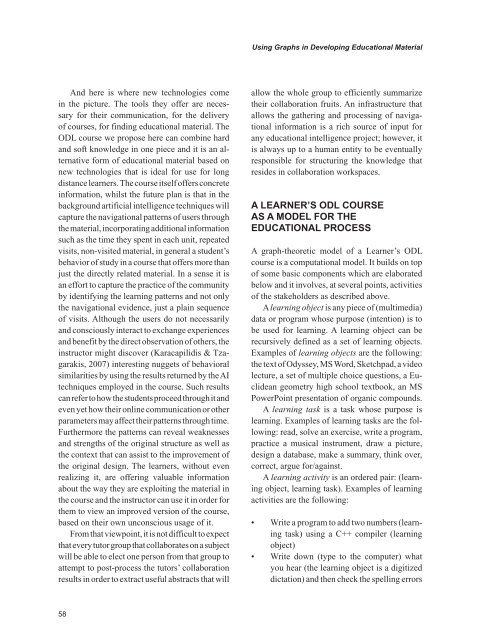Web-based Learning Solutions for Communities of Practice
Web-based Learning Solutions for Communities of Practice
Web-based Learning Solutions for Communities of Practice
You also want an ePaper? Increase the reach of your titles
YUMPU automatically turns print PDFs into web optimized ePapers that Google loves.
And here is where new technologies come<br />
in the picture. The tools they <strong>of</strong>fer are necessary<br />
<strong>for</strong> their communication, <strong>for</strong> the delivery<br />
<strong>of</strong> courses, <strong>for</strong> finding educational material. The<br />
ODL course we propose here can combine hard<br />
and s<strong>of</strong>t knowledge in one piece and it is an alternative<br />
<strong>for</strong>m <strong>of</strong> educational material <strong>based</strong> on<br />
new technologies that is ideal <strong>for</strong> use <strong>for</strong> long<br />
distance learners. The course itself <strong>of</strong>fers concrete<br />
in<strong>for</strong>mation, whilst the future plan is that in the<br />
background artificial intelligence techniques will<br />
capture the navigational patterns <strong>of</strong> users through<br />
the material, incorporating additional in<strong>for</strong>mation<br />
such as the time they spent in each unit, repeated<br />
visits, non-visited material, in general a student’s<br />
behavior <strong>of</strong> study in a course that <strong>of</strong>fers more than<br />
just the directly related material. In a sense it is<br />
an ef<strong>for</strong>t to capture the practice <strong>of</strong> the community<br />
by identifying the learning patterns and not only<br />
the navigational evidence, just a plain sequence<br />
<strong>of</strong> visits. Although the users do not necessarily<br />
and consciously interact to exchange experiences<br />
and benefit by the direct observation <strong>of</strong> others, the<br />
instructor might discover (Karacapilidis & Tzagarakis,<br />
2007) interesting nuggets <strong>of</strong> behavioral<br />
similarities by using the results returned by the AI<br />
techniques employed in the course. Such results<br />
can refer to how the students proceed through it and<br />
even yet how their online communication or other<br />
parameters may affect their patterns through time.<br />
Furthermore the patterns can reveal weaknesses<br />
and strengths <strong>of</strong> the original structure as well as<br />
the context that can assist to the improvement <strong>of</strong><br />
the original design. The learners, without even<br />
realizing it, are <strong>of</strong>fering valuable in<strong>for</strong>mation<br />
about the way they are exploiting the material in<br />
the course and the instructor can use it in order <strong>for</strong><br />
them to view an improved version <strong>of</strong> the course,<br />
<strong>based</strong> on their own unconscious usage <strong>of</strong> it.<br />
From that viewpoint, it is not difficult to expect<br />
that every tutor group that collaborates on a subject<br />
will be able to elect one person from that group to<br />
attempt to post-process the tutors’ collaboration<br />
results in order to extract useful abstracts that will<br />
58<br />
Using Graphs in Developing Educational Material<br />
allow the whole group to efficiently summarize<br />
their collaboration fruits. An infrastructure that<br />
allows the gathering and processing <strong>of</strong> navigational<br />
in<strong>for</strong>mation is a rich source <strong>of</strong> input <strong>for</strong><br />
any educational intelligence project; however, it<br />
is always up to a human entity to be eventually<br />
responsible <strong>for</strong> structuring the knowledge that<br />
resides in collaboration workspaces.<br />
A LEARNER’S ODL COURSE<br />
AS A MODEL FOR THE<br />
EDUCATIONAL PROCESS<br />
A graph-theoretic model <strong>of</strong> a Learner’s ODL<br />
course is a computational model. It builds on top<br />
<strong>of</strong> some basic components which are elaborated<br />
below and it involves, at several points, activities<br />
<strong>of</strong> the stakeholders as described above.<br />
A learning object is any piece <strong>of</strong> (multimedia)<br />
data or program whose purpose (intention) is to<br />
be used <strong>for</strong> learning. A learning object can be<br />
recursively defined as a set <strong>of</strong> learning objects.<br />
Examples <strong>of</strong> learning objects are the following:<br />
the text <strong>of</strong> Odyssey, MS Word, Sketchpad, a video<br />
lecture, a set <strong>of</strong> multiple choice questions, a Euclidean<br />
geometry high school textbook, an MS<br />
PowerPoint presentation <strong>of</strong> organic compounds.<br />
A learning task is a task whose purpose is<br />
learning. Examples <strong>of</strong> learning tasks are the following:<br />
read, solve an exercise, write a program,<br />
practice a musical instrument, draw a picture,<br />
design a database, make a summary, think over,<br />
correct, argue <strong>for</strong>/against.<br />
A learning activity is an ordered pair: (learning<br />
object, learning task). Examples <strong>of</strong> learning<br />
activities are the following:<br />
•<br />
•<br />
Write a program to add two numbers (learning<br />
task) using a C++ compiler (learning<br />
object)<br />
Write down (type to the computer) what<br />
you hear (the learning object is a digitized<br />
dictation) and then check the spelling errors



